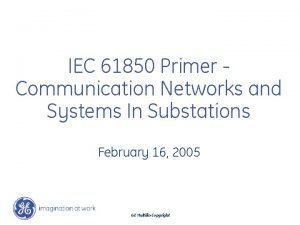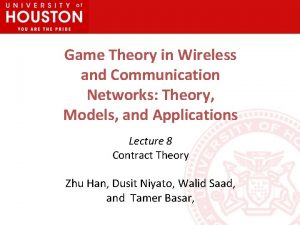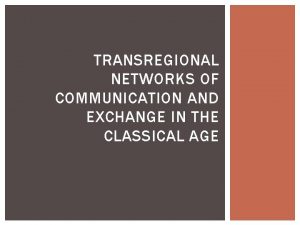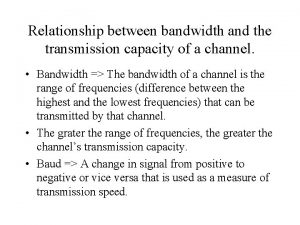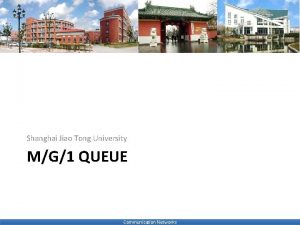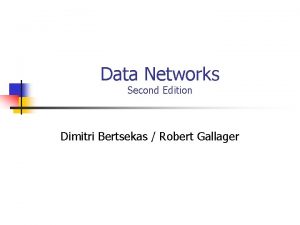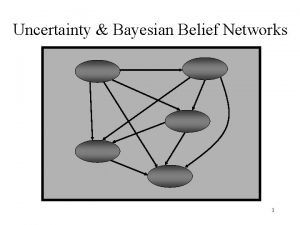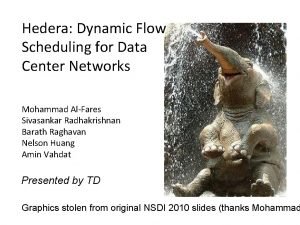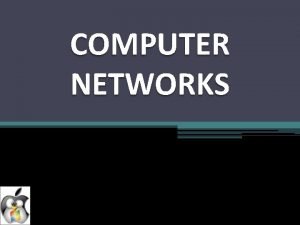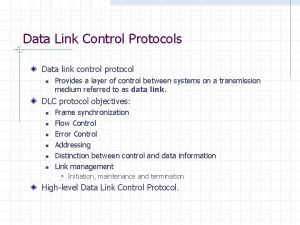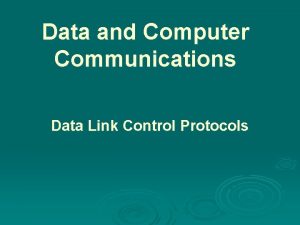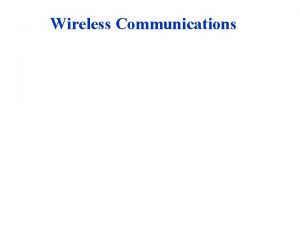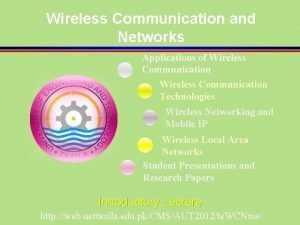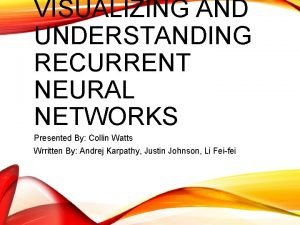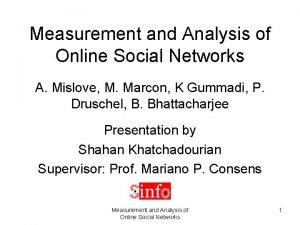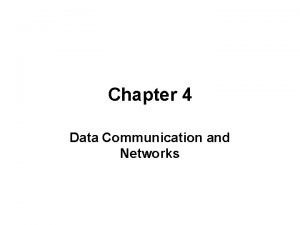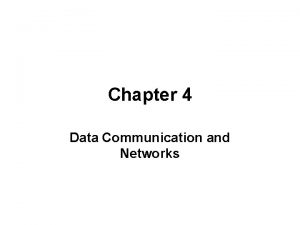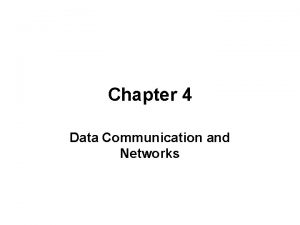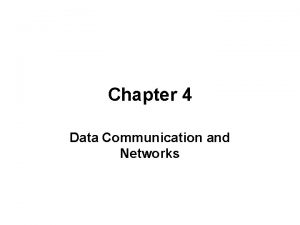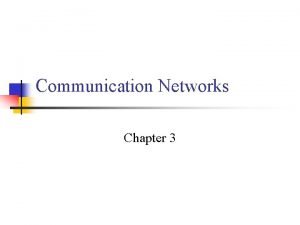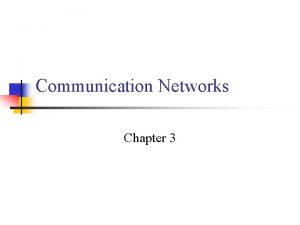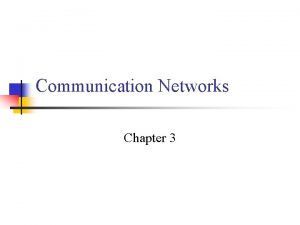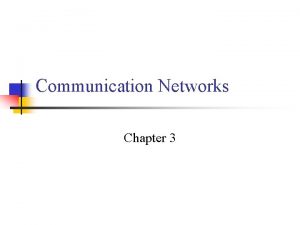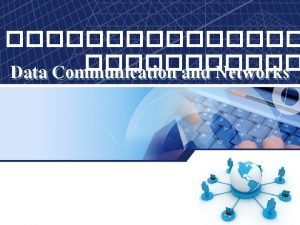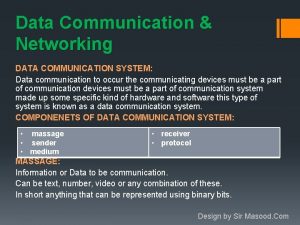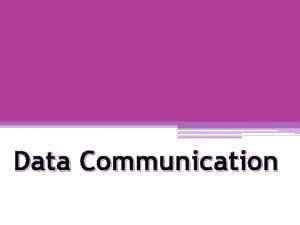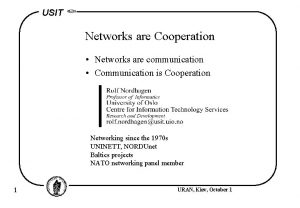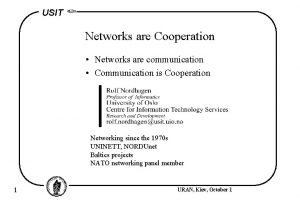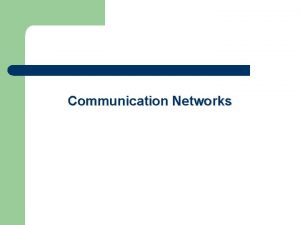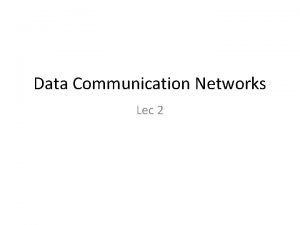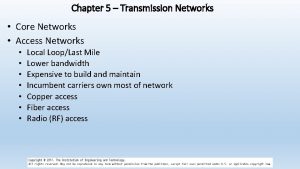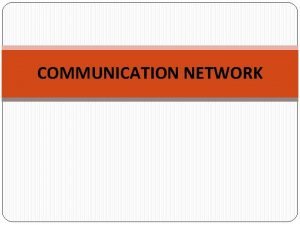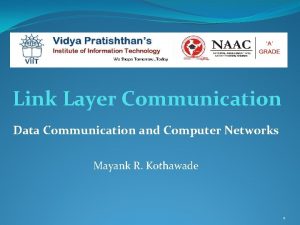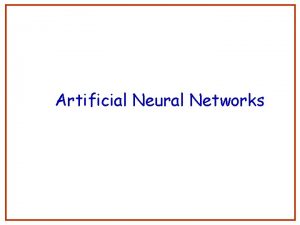Chapter 4 Data Communication and Networks Data Communication



























- Slides: 27

Chapter 4: Data Communication and Networks • Data Communication: Transferring data in its different types: text, sound, images…, etc between at least two nodes, i. e. computers or devices. • Data is transferred (or communicated) in its binary form after transferring it using one of the standard codes like: ASCII: American Standard Code for Information Interchange. Chapter 4: Data Communication and Networks

• Code: A unique binary number assigned to a symbol or a character. • Computer Network: A group of computers (at least two) that are connected via various communication media and are able to communicate (interchange) data. Chapter 4: Data Communication and Networks

• Uses of Computer Networks 1 - Sharing Hardware: Sharing a printer. Chapter 4: Data Communication and Networks 3

2 - Sharing Software: Sharing applications and Programs and software tools. For example this can be accomplished by sharing a set of CDs or DVDs on a central server. • Other uses of Networks 1 - Communication between users: video messages, faxes, chatting, and voice messages. 2 - Providing services for customers, examples are: E- Commerce, E-Government. Chapter 4: Data Communication and Networks

• Types of Networks There are two types of Networks classified according to the geographical distances between connected computers: 1 - Local Area Networks (LANs) 2 - Wide Area Network (WAN) Chapter 4: Data Communication and Networks

1 - Local Area Networks (LANs): A network which covers a single floor, or perhaps an entire building. LAN Characteristics: • Used in small geographical areas. • Offer high-speed communications. • Use LAN-specific devices such as repeaters, hubs and network interface cards. Chapter 4: Data Communication and Networks

LANs are divided into two Types: A- Client/ Server Networks: Server is the main and usually the most powerful computer among other computers in the network. It is called server because it provides services for other computers that are connected with it in the LAN Chapter 4: Data Communication and Networks

Chapter 4: Data Communication and Networks 8

B- Peer-to-Peer Networks: All computers in this type of networks are equivalent. The server is not used, individual computers share data directly with others. Chapter 4: Data Communication and Networks 9

2 - Wide Area Networks (WAN): • In this network computers are connected to each other over a large area. • WAN is used in offices and governmental departments located in different cities within the same country, Or in different countries. • It is also used to connect the ATM banks. • The largest WAN is the Internet. Chapter 4: Data Communication and Networks

• WAN Characteristics: • Cover large areas – may span the world. • Compared to LANs – slow speed communication. • Devices such as routers, modems and WAN switches is used. Chapter 4: Data Communication and Networks

• Network Topologies: Topology: The geometric arrangement of network devices (network nodes) is its topology. There are three main topologies: 1 - Star Topology (Star Network): • In this network, all the computers are connected to a server via a communication HUB. • In other words we can say that one of the computers or a network device such as a hub or switch serves as a central point for all messages. Chapter 4: Data Communication and Networks

• When a computer wants to send a message to another computer, it sends the message to the central node. • The central node then forwards the message to the computer it is addressed to. Chapter 4: Data Communication and Networks 13

2 - Ring Topology (Ring Network) • All computers and other communication devices are connected in a common loop i. e. each computer is connected to its downstream (adjacent) computer. • Electronic signals are passed around the loop until they reach the specified destination. Chapter 4: Data Communication and Networks

• When a computer wishes to send a message to another computer, it sends the message to the next computer in the ring. Chapter 4: Data Communication and Networks 15

• If the message is not addressed to computer receiving it, the computer forwards the message to the next computer. • This process repeats itself until the message reaches the correct computer. Chapter 4: Data Communication and Networks

3 - Bus Network All computers are connected to a common channel (Bus). The bus line requires a special terminator at the end of the line to absorb signals so that they do not reflect back down the line. Chapter 4: Data Communication and Networks

• Data Communication Hardware 1 - Modem • Modem stands for “Modulate/Demodulate”. The modem sends information from your computer across the telephone system (line). • The modem at the other end of the phone line, converts the signal back into a format that can be understood by the receiving computer. Chapter 4: Data Communication and Networks

Chapter 4: Data Communication and Networks 19

• Digital vs. Analogue: • A digital system uses 1 or 0 to transmit data or to represent data. Thus, a digital clock will display whole seconds, whole minutes and whole hours. • An analogue system, such as a traditional clock, does not use multiples of 1 or 0, but rather uses the full range of numbers, including fractions. In this way, an analogue clock can display fractions of a second. Chapter 4: Data Communication and Networks

• Modulation: Converting digital signal to its equivalent analogue signal. • Demodulation: Converting analogue signal to its equivalent digital signal. • Speed of the modem in transmitting and receiving data is measured in Baud. • For example we say the speed of the modem is 56 kilo bit per second (56 kbps) this means that the baud rate of the Modem is 56 Kilobits per second. Chapter 4: Data Communication and Networks

2 - Network Interface Card (NIC): It is a card for interfacing and connecting computers within LAN. Chapter 4: Data Communication and Networks 22

• Transmission Media There are two types of transmission media: A- Wired Media. B- Wireless media. Wired media are divided to: 1 - Twisted pairs. 2 - Coaxial cables. 3 - Fiber optics. Chapter 4: Data Communication and Networks

1 - Twisted Pairs: It is the most commonly used network cabling, is similar to the wiring that is used to connect your telephone. Chapter 4: Data Communication and Networks 24

2 - Coaxial Cables: These are similar to the cables used for connecting television to the antenna or the receiver, and they were developed to carry high-speed, interface-free video transmission Chapter 4: Data Communication and Networks 25

3 - Fiber Optics: Clear glass or plastic fiber strands. Each is about the thickness of a human hair. It is used to transfer data represented by light pulses. (To represent digital data signals) Chapter 4: Data Communication and Networks 26

B- Wireless Media: • Radio Waves. • Microwaves. • Satellites Protocols To operate efficiently, any communicationsbased system must have an established set of rules — its protocols — to govern its operation. Popular protocols for LANs are TCP/IP and IPX/SPX. Chapter 4: Data Communication and Networks
 Differentiate between virtual circuit and datagram network
Differentiate between virtual circuit and datagram network Basestore iptv
Basestore iptv Iec 61850 communication networks and systems in substations
Iec 61850 communication networks and systems in substations Game theory in wireless and communication networks
Game theory in wireless and communication networks Networks of communication and exchange
Networks of communication and exchange Introduction to communication networks
Introduction to communication networks A communication processor that connects dissimilar networks
A communication processor that connects dissimilar networks Industrial communication networks
Industrial communication networks Pollaczek khinchin formula
Pollaczek khinchin formula Delay models in data networks
Delay models in data networks Modeling relational data with graph convolutional networks
Modeling relational data with graph convolutional networks Data networks bertsekas
Data networks bertsekas Switching in data link layer
Switching in data link layer Bayesian belief networks in data mining
Bayesian belief networks in data mining Data link
Data link Hdlc and ppp
Hdlc and ppp Data encoding techniques in computer networks
Data encoding techniques in computer networks Hedera: dynamic flow scheduling for data center networks
Hedera: dynamic flow scheduling for data center networks Elementary data link protocols in computer networks
Elementary data link protocols in computer networks Link control protocol
Link control protocol Data link protocols
Data link protocols Networks and graphs: circuits, paths, and graph structures
Networks and graphs: circuits, paths, and graph structures Benefits of transferring data over a wired network
Benefits of transferring data over a wired network Andrea goldsmith wireless communications
Andrea goldsmith wireless communications Constrained nodes and constrained networks
Constrained nodes and constrained networks Visualizing and understanding recurrent networks
Visualizing and understanding recurrent networks Visualizing and understanding convolutional networks
Visualizing and understanding convolutional networks Measurement and analysis of online social networks
Measurement and analysis of online social networks


